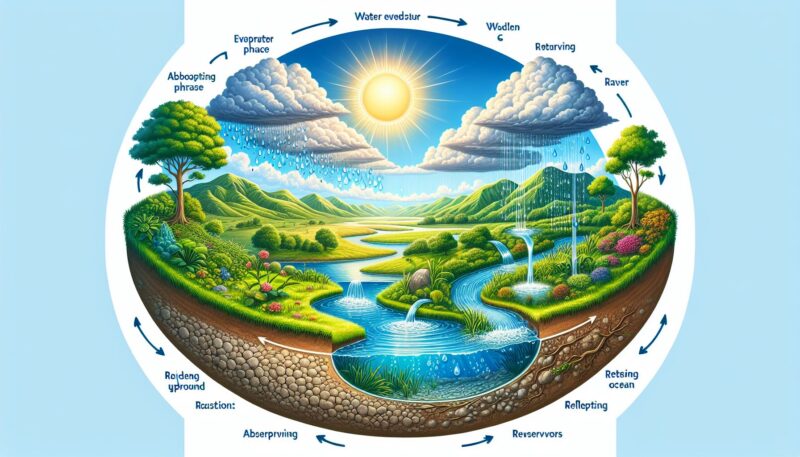Water is the lifeblood of our planet, and understanding how it travels through the environment is essential for the sustenance of all life forms, as well as for the management of this precious resource. At the heart of this understanding lies the hydrologic cycle, an endlessly dynamic process that circulates water across various phases and places. In this article, we will delve into the intricacies of the hydrologic cycle, exploring each stage and its significance to our world.
The Stages of the Hydrologic Cycle
The hydrologic cycle, also known as the water cycle, is a complex system driven by the sun’s energy and governed by the laws of physics. It comprises several key processes: evaporation, transpiration, condensation, precipitation, infiltration, percolation, runoff, and streamflow. Let’s examine each of these in detail.
Evaporation: Water’s Ascend
Evaporation is the process of water turning from a liquid into vapor. The sun’s heat energizes water molecules in rivers, lakes, and oceans, causing them to move faster and eventually break the surface tension to escape into the air. This invisible vapor accumulates in the atmosphere, contributing to the moisture content that will later fall as precipitation.
Transpiration: A Plant’s Contribution
Plants also play a critical role in the water cycle through transpiration. This process involves the absorption of water by plant roots and its journey through stems and leaves before finally evaporating from tiny pores called stomata. Remarkably, it’s estimated that about 10% of the moisture in the atmosphere is released by plants through transpiration.[^1]
Condensation: The Gathering of Clouds
As water vapor rises, it encounters cooler temperatures in the atmosphere. This cooling prompts condensation – the transformation of vapor back into liquid water droplets. These droplets cluster around dust particles, forming clouds. Condensation is a crucial phase, as it sets the stage for the return of water to the Earth’s surface.
Precipitation: From Clouds to Earth
When countless tiny droplets within a cloud merge to become heavier, they can no longer float in the air. The result is precipitation, which returns water to the Earth in various forms, including rain, snow, sleet, or hail. The amount and type of precipitation received in a particular area are pivotal factors in shaping its ecosystem and water resources.
Infiltration and Percolation: Earth’s Natural Filtering
Upon reaching the ground, precipitation can take one of two paths: it can run off or it can infiltrate the soil. Infiltration is the process by which water seeps into the soil, and percolation refers to the movement of this water further down into the ground. These stages act as natural filtration, removing impurities from water as it travels through sediment layers.
Runoff and Streamflow: Water on the Move
Water that does not infiltrate the soil becomes runoff. It flows over the land, moving towards streams, rivers, and eventually oceans. Runoff can accelerate soil erosion and carry pollutants into larger bodies of water. Streamflow, the flow of water within a stream or river, is a key component of the runoff process and is essential for transporting nutrients and sediments throughout a watershed.
Groundwater: The Slow Journey Underground
Some infiltrated water reaches deeper underground to become groundwater, where it can travel through aquifers – porous layers of rock and sediment that store water. This slow journey is critical, as it can replenish these natural reservoirs and provide a consistent supply of fresh water, even during dry periods.
Recharge and Discharge: Aquifer Dynamics
Groundwater recharge is the process through which water enters an aquifer, while discharge refers to the exit of water from an aquifer back to the Earth’s surface, usually emerging at springs or seepage into rivers and wetlands. The balance between recharge and discharge is crucial for sustaining groundwater levels and preventing over-extraction.
The Importance of the Hydrologic Cycle
The hydrologic cycle is fundamental to life on Earth for several reasons:
- Water Supply: It is the natural mechanism that replenishes freshwater resources, ensuring the availability of water for drinking, agriculture, industry, and ecosystem support.
- Climate Regulation: The exchange of water between the surface and the atmosphere helps regulate temperature and climate patterns globally.
- Nutrient Distribution: Water movement across land, through rivers, and into oceans distributes necessary nutrients, supporting a wide range of biological processes.
- Habitat Formation: Different stages of the cycle contribute to the creation and maintenance of a diverse set of habitats, from rivers and lakes to estuaries and wetlands.
The Human Impact on the Hydrologic Cycle
Human activities, such as urbanization, deforestation, and the use of water for agriculture and industry, have significant impacts on the hydrologic cycle. Land-use changes can alter water infiltration rates, increase runoff, and exacerbate flooding. Climate change, fueled by greenhouse gas emissions, is causing alterations in precipitation patterns, intensifying droughts and increasing the frequency of extreme weather events.
Consequently, there are measures we can take to mitigate our impact, such as:
- Water Conservation: Employing strategies aimed at reducing water waste can help maintain a balance in the hydrologic cycle. Simple methods like fixing leaks in homes and using water-efficient appliances can make a noticeable difference.
- Protected Areas: Preserving natural landscapes, such as wetlands and forests, aids in maintaining natural infiltration and groundwater recharge processes.
Conclusion
The hydrologic cycle is a sophisticated and essential component of our planet. By appreciating its complexity and recognizing our role within it, we can take better steps to protect and manage our water resources for future generations.
[^1]: National Oceanic and Atmospheric Administration (NOAA) – Water Cycle – Transpiration. (https://www.noaa.gov/education/resource-collections/freshwater/water-cycle-transpiration)
Understanding the hydrologic cycle is fundamental to the sustainability of life and the well-being of ecosystems worldwide. Its continuous motion maintains the balance between the water in our oceans, atmosphere, rivers, and within the ground. Human influence on this cycle presents both challenges and opportunities for better stewardship of Earth’s water resources, ensuring their availability for all forms of life now and into the future.
